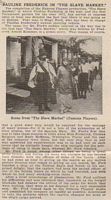

The Slave Market (1916) Famous Players Film Co. Distributor: Paramount Pictures Corp. Presenter: Daniel Frohman. Director: Hugh Ford. Scenario: Clara S. Beranger. Camera, Ned Van Buren. Cast: Pauline Frederick, Thomas Meighan, Albert Hart, Ruby Hoffman, Wellington Playter. 5 reels. This film appears to be LOST
| Ramona | Pauline Frederick |
| John Barton | Thomas Meighan |
| Firebrand | Albert Hart |
| Anna | Ruby Hoffman |
| Portuguese Joe | Wellington Playter |
Famous Players does not seem to have expended any unusual energy in the photoplay version of Frederic Arnold Kummer's play, "The Slave Market." The scrip [sic] calls for the depiction of the boarding by pirates of a sailing vessel and the capture of a Spanish maiden of gentle upbringing. All of which lends itself admirably to picturizing, but it seems to have been done in the cheapest manner possible. The band of pirates number about six or eight and the crew of the invaded vessel are about equal, numerically. The "big" scene in the legitimate stage version, as played by Florence Reed, was Ramona's (Pauline Frederick) killing of Firebrand, in the picture it is about the tamest kind of affair. Miss Frederick, in fact, does not dominate at any time, whereas Miss Reed was starred, and practically sustained what little merit there was to the legitimate stage presentation. Then again the slave market is depicted with a comparatively small mob of bidders and but one other slave besides Miss Frederick. The whole affair partook of the flavor of "piking."
"The Slave Market"
Pauline Frederick Plays a Strong Lead in a Stirring Melodrama of the Spanish Main.
Reviewed by George Blaisdell.
 |
There are pirates and pirate ships, chests of gold and man-to-man battles in "The Slave Market," the Famous Players release for January 1. The subject is a stirring melodrama of the Spanish Main, and the for semi-tropical land backgrounds Director Hugh Ford took his company of players, headed by Pauline Frederick, into the field of the special activities of the old-time pirates. The Cuban scenes in their richness of setting are ample compensation for the journey.
Miss Frederick has the role of the convent-bred daughter of a governor of one of the West Indian islands. On her way out from Spain to meet her father she is captured by pirates, and by the leader of them is declared to be his slave. It is a strongly emotional role, that of Ramona, one suited to the talent of Miss Frederick. A great majority of the situations in which she figures are of stress, but there are others that are tender, when she is thrown into the company of the man whom she loves and who eventually rescues her and escorts her to the priest.
Thomas Meighan is John Barton, the adventurer into whose hands falls the chest of gold buried by the pirates and who with the contents buys the freedom of Ramona. Albert Hart is Firebrand, the big pirate, who attempts through fear of his lash to win the submission if not the love of Ramona. Firebrand is as fierce as any one would wish him to be, as convincing a pirate as ever scuttled a ship. Wellington Player is his chief of staff. Ruby Hoffman is the discarded favorite of Firebrand.
"The Slave market" will make a strong subject for any house. It is a well-made melodrama.
THE SLAVE MARKET (Famous Players--Five Parts--January 1)--The cast: Ramona (Pauline Frederick); John Barton (Thomas Meighan); Firebrand (Albert Hart); Anna (Ruby Hoffman); Portuguese Joe (Wellington Playter).
Ramona is the daughter of the governor of Port Royal. She is a school girl living in Spain. John Barton, a soldier of fortune, is cast ashore in Spain penniless and scrapes an acquaintance with Ramona by rescuing one of her pets. He is putting up at a rather questionable tavern where he learns of a huge treasure buried by "Firebrand", a pirate, and secures plans of the spot in which it is concealed.
Ramona sails for Port Royal and Barton is on the same ship. "Firebrand" attacks the ship and captures as part of his booty Ramona, whom he appropriates for himself after Barton has been knocked overboard in her defense. Until the acquisition of Ramona, Firebrand's favorite has been Anna, who now becomes jealous of the Spanish beauty. After attempting to make Ramona accept his attentions peacefully, Firebrand vents his wrath upon her and orders her confined in one of his cabins.
Barton, recovering from his injuries sufficiently to make his way ashore, stumbles upon the cabin in which Ramona is a prisoner but the jealous Anna discovers him and informs Firebrand of the supposed duplicity of his new favorite. The pirate chief rushes to the cabin and when he attempts to force his attentions upon Ramona she kills him.
Anna denounces Ramona as the culprit and, in a fit of vengeance, suggests that Ramona be sold as a slave in the public market. Her rare beauty causes lively bidding among the men who attend the sale. Meanwhile Barton has gone in search of the buried treasure and has found it. He has bought a horse on which he comes in search of Ramona--only to find he on the slave block with a horde of men frantically bidding on her.
Plunging into the crowd, he fights his was to the front and forces the bidding until, after a soul-stirring scene, he succeeds in vanquishing his rivals, and rides off triumphant in search of a minister.
The photoplay at the Strand is called "The Slave Island." [sic] It has to commend it an unusually thrilling story and the beautiful Pauline Frederick.
Last revised, March 15, 2009